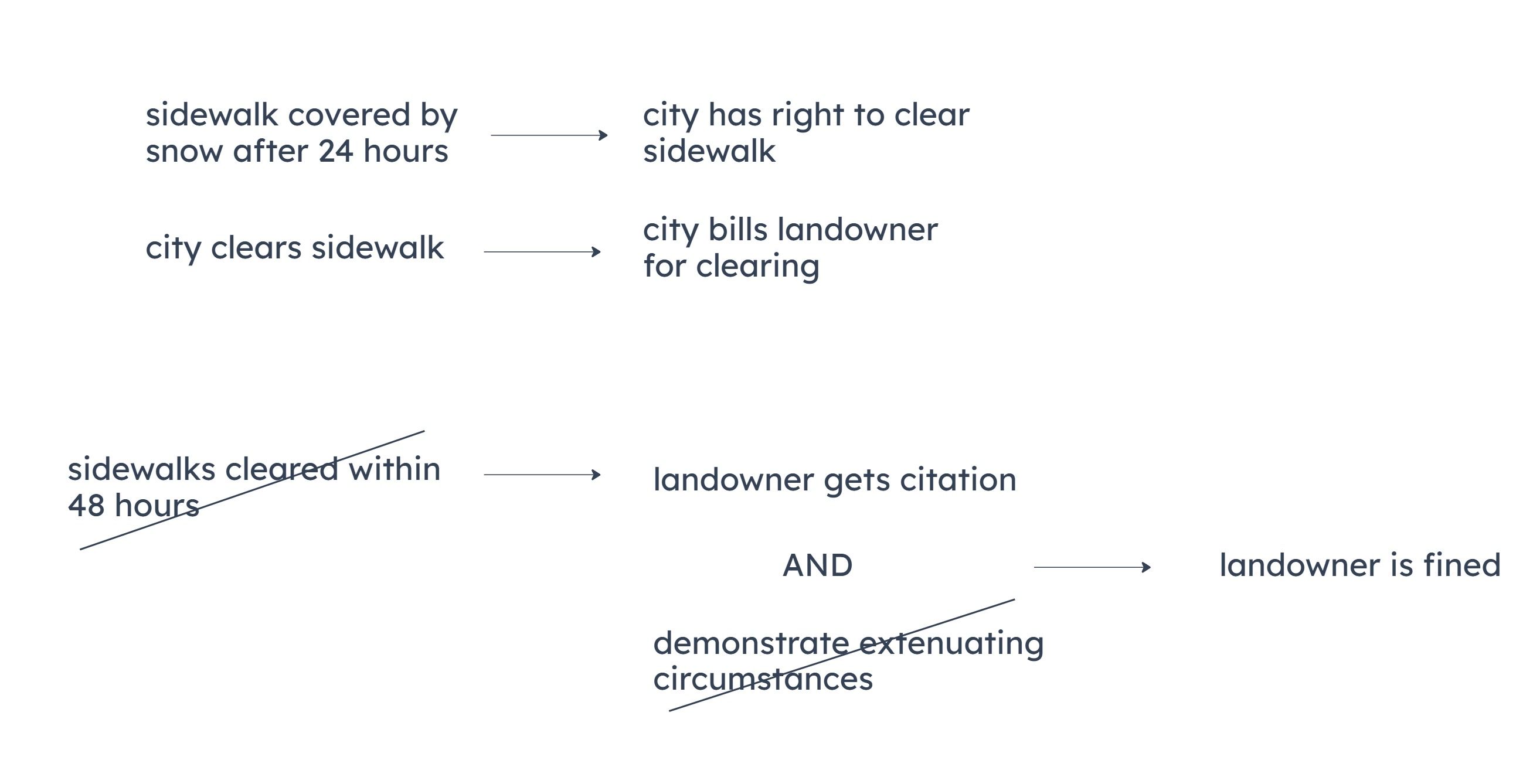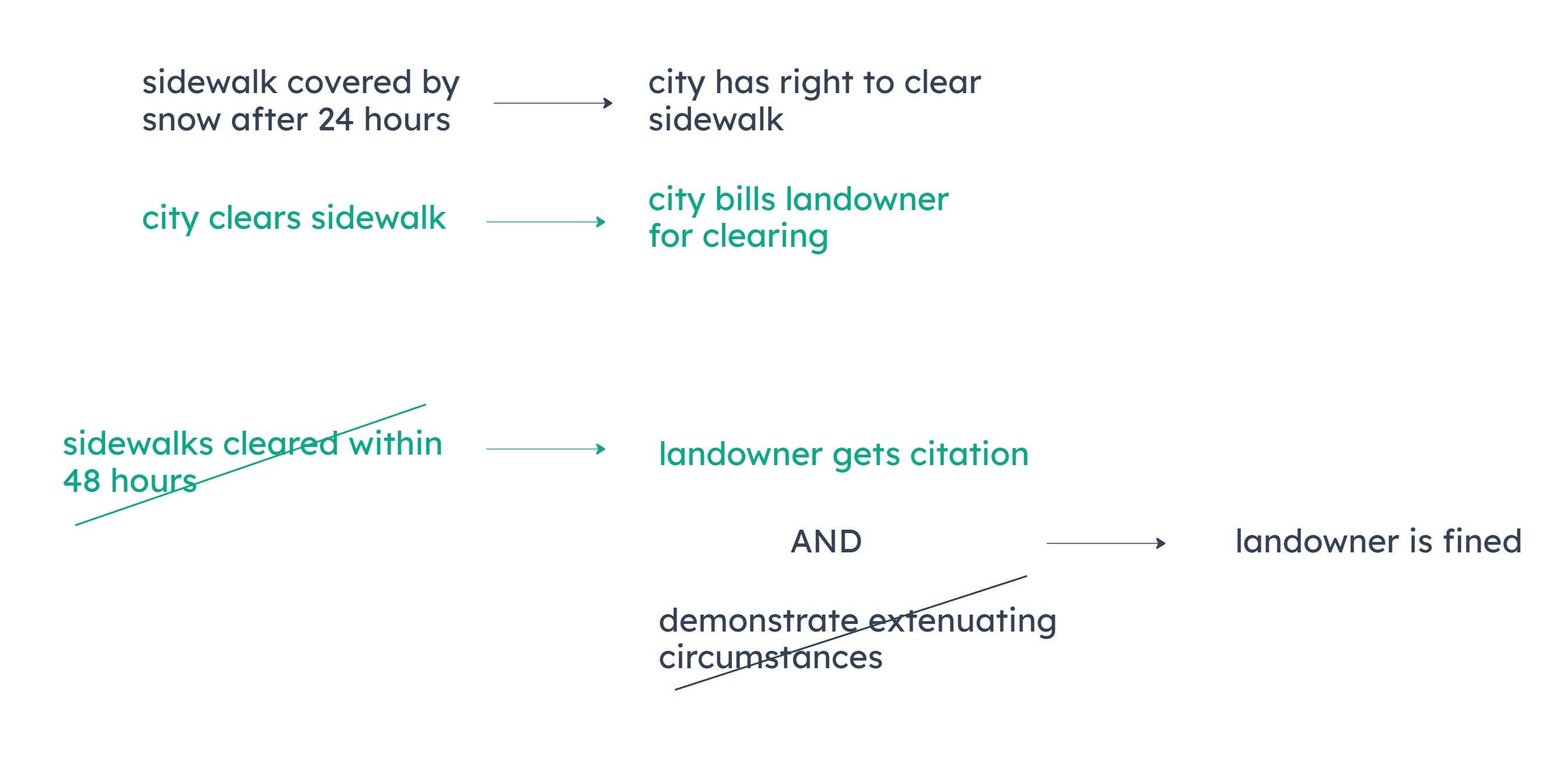City official: Landowners must clear the snow from the sidewalks along the edge of their property by 24 hours after the end of a snowstorm. The city has the right to clear any sidewalk that is still covered more than 24 hours after a snowstorm’s end, and whenever it does so, it will bill the landowner for the service. All landowners whose sidewalks have not been cleared within 48 hours of the end of a snowstorm will receive citations, which always result in fines unless the landowners can demonstrate extenuating circumstances.
Summary
The stimulus can be diagrammed as follows:

Notable Valid Inferences
If the sidewalk is covered by snow after 24 hours, the city might bill the landowner for the cleaning.
A
If the city clears a sidewalk of snow 50 hours after the end of a snowstorm, the owner will be billed for the service and will receive a citation.
Must be true. As shown below, if the city clears the sidewalk, the owner will be billed. If the sidewalk hasn’t been cleared within 48 hours, then the owner will receive a citation.

B
All landowners who fail to clear their sidewalks by 24 hours after the end of a snowstorm will be billed by the city for snow removal.
Could be false. If the sidewalk is covered after 24 hours, the city has the right to clear the sidewalk, but this isn’t a guarantee that the city will actually do it. It could be the case that the city doesn’t clear someone’s sidewalk (and that they wouldn’t be billed).
C
All sidewalks in the city will be cleared of snow within 50 hours of the end of a snowstorm.
Could be false. If the sidewalk is covered by snow after 24 hours, the city has the right to clear it, but the city isn’t required to do so. If the sidewalk isn’t cleared after 48 hours, the landowner is cited, but this doesn’t guarantee that the sidewalk will be cleared.
D
Nearly all landowners who do not clear their sidewalks within 48 hours after the end of a snowstorm will be fined.
Could be false. The stimulus does not provide information to support inferences about quantities of landowners; we don’t know what happens to “nearly all” landowners. It could be the case that these landowners’ sidewalks were cleared by the city before 48 hours.
E
Landowners who can demonstrate extenuating circumstances will not be billed by the city for snow removal service.
Could be false. The bill comes from performing the service of clearing the sidewalk; it is still the case that if these landowners receive the service of the city clearing their sidewalks, then they will be billed.
Amal: But allocating new revenue to transportation will free up existing transportation funds for use in other areas. Thus, the new revenue will nonetheless help reduce budget shortfalls in other areas.
A
there will be shortfalls in budget areas other than transportation
B
the amount of money currently allocated to transportation is adequate
C
new revenue from leasing government-owned toll bridges should be allocated to transportation
D
new revenue allocated to transportation will result in existing transportation funds being reallocated to other areas
E
leasing government-owned toll bridges to private investors will be financially beneficial to the government
A
The periodic table lists the properties of the elements, and presents them in a pattern to represent relations between them, while an ordinary dictionary mostly just gives an alphabetical ordering to the words it defines.
B
There is wide agreement about the data on the periodic table, while disagreements between the definitions in different ordinary dictionaries are likely to be relevant to legal interpretation.
C
The use of a periodic table as a reference source actually came much later in history than the use of ordinary dictionaries to describe the meanings of words.
D
The periodic table contains only a relatively small amount of information that could, in theory, be memorized, while the information in an ordinary dictionary is likely to be too large for any one person to know all at once.
E
The periodic table is used primarily by chemists, while ordinary dictionaries are not used primarily by legal scholars and legal interpreters.